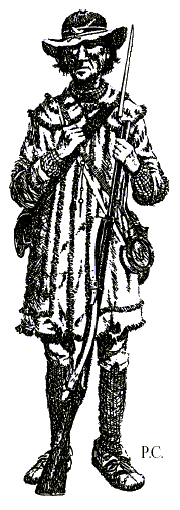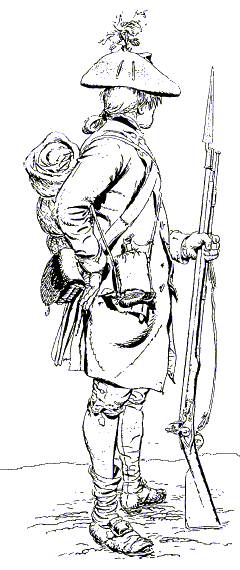APPENDIX
I
“They answered him with three
cheers ..."
New Jersey Common Soldiers' Pension Depositions
Narrators
John Ackerman, private 1st New Jersey
David Cooper, private 1st New Jersey
James Jordan, private 2nd New Jersey
Samuel Leonard, private 3rd New Jersey
Nathaniel Lyon, private 4th New Jersey
William Todd, private 2nd New Jersey
Frederick Van Lew, private 2nd New
Jersey
Private Asa Woodward, nine-month levy, 4th New Jersey
Only rarely are ordinary Revolutionary soldiers' voices heard; the depositions given when applying for veteran's pensions in the 19th century often contain remarkable personal accounts that sometimes give a vivid sense of immediacy. Here are several New Jersey soldiers’ narratives supplying little-known details of the Monmouth campaign and battle:
Private John Ackerman, nine-month levy, 1st New Jersey, recounted details of the morning retreat of Lee's advance detachment, "his regement on that day was ordered by the Colo to retreat which was effected by passing through a morass in which he lost his shoes ‑ After retreating through this morass, his regement came to the road just as the troops under the immediate command of Gen Washington were passing ‑ Gen Washington halted his troops, and the retreating Regement was immediately paraded having become disordered in retreating throug the [morass] He well recollects that Gen Washington on that occasion asked the troops if they could fight and that they answered him with three cheers ..."1
Private David Cooper, nine-month levy, 1st New Jersey, "... in May 1778 ... he was drafted in Morris County New Jersey where he then lived & where he was born ... for the period of nine months ... he belonged to the 1t Regiment ... we joined the Jersey Brigade ... at Mt. Holly where we remained about three weeks untill the British crossed the Delaware / we were then ordered to march in their advance towards Bordentown throwing all possible obstructions in their way by tearing down Bridges felling trees &c &c When we crossed the Draw Bridge west of Bordentown & after cutting it almost down we entrenched on the West side of Crosswicks Creek & remained about 4 hours when we heard firing in another direction we then had orders to march & went on through the country to English Town where we stayed 3 days This was 3 Miles from the Battle ground at Monmouth / On the morning of the Battle we were marched within a Mile of Monmouth [and] there changed our direction & Marched to the ground where the battle was fought / we were placed on the extreme Left & in the rear of the first lines where we remained during the action & then we went back to Englishtown ‑ stayed two days & were ordered to march to Elizabethtown ..."1
Private James Jordan, nine-month levy, 2nd New Jersey, recalled of 28 June, "they were led on by Maxwell to attack the left Wing of the British and had a very severe engagement / this was probably about eight or nine OClock in the morning [we] had no breakfast nor any thing to eat that day / the engagement was continued for some time when a retreat was ordered and fought all the way as they retreated back towards and past the Court House at Montmouth / After we had passed the Court House a little we were met by Gen. Washington who came up with the Main Army riding a White Horse this petitioner was within a yard of him and heard him address Gen. Lee by asking him "What is this you have been about to day" / This was the principal Battle he was in during the time he served / from Monmouth after the battle he was, with his regiment, marched to Elizabeth Town... [they] lay there until Fall. The second regiment of the Jersey Blues... was ordered to New Ark in [New Jersey] ... to Winter Quarters ..."1

New Jersey Brigade common soldiers likely wore hunting shirts, with breeches or overalls, in the spring and summer of 1778. Levies drafted from the militia to serve for nine months in the state’s Continental regiments were also issued hunting shirts and breeches, unless they provided their own clothing. Maryland, New Jersey, and New York had substantial numbers of levies with their regiments at the Battle of Monmouth. Illustration by Peter F. Copeland. Courtesy of the artist.
Private Samuel Leonard, nine-month levy, 3rd New Jersey, "was in the battle at Monmouth and received a severe wound in that battle the twenty eighth of June: that on account of the said wound he was Confined to the hospital for about Eight months, that on the fifth day of March [1779] ... he was honorably discharged ..."1
Private Nathaniel Lyon, nine-month levy, 4th New Jersey, "volunteered in the summer of 1778 for nine months in Gen Maxwell's (or Maxfield's) brigade ... They marched to join the American forces at Mount Holly & remained there 10 days or a fortnight until the British from Philadelphia compelled them to move. Two regiments, of which his [the 4th New Jersey] was one, marched around through Trenton, Maidenhead, English Town & so forward to Monmouth where he was engaged in the battle about a mile north of Monmouth Court house. Gen. Maxwell's brigade was not much exposed during the fighting. The night of the battle the applicant was detached to assist in burying the dead, & the morning after was ordered to Princeton in charge of the sick. Remaining at Princeton about a week he went to join his company at Elizabethtown ..."1
Private William Todd, nine-month levy, 2nd New Jersey, stated, "a short time after joining the Army … Monmouth battle took place …was there and Engaged in said Battle and received a wound from a Musket ball in his thigh during the Engagement." In a supporting deposition his brother, George Todd, recalled that at the time of the Battle of Monmouth he "was a soldier in the Militia, and understanding that his brother the said William Todd was Killed in the battle he went in pursuit of him the day after and found him at English Town about one mile & a half from the Battle Ground on duty as a soldier ..."1
Private Frederick Van Lew [VanLue], nine-month levy, 2nd New Jersey, “Washington Attacked them at Monmouth, and gain[ed] the victory over them it was on sunday the hotest day he ever knew remained there two days after the battle, and then left there for Elizabeth Town, where the whole Army remained ..."1 Van Lew, a weaver by trade, was 23 years old at the time of his 1778 service, joined the regiment 28 May 1778 and deserted 20 November 1778. He returned in December 1778 and was discharged February 28, 1779. A letter from 2nd New Jersey Captain Jonathan Phillips to Colonel Israel Shreve noted, “the Greates[t] part of my Recruts has marched, the bearer Fredrick Van‑Lew & three others who are with him are Compleat with armes and Acqutomets [accoutrements] ..."2
Private Asa Woodward , nine-month levy, 4th New Jersey, “in a skirmage the day before the Battle of Monmouth in the State of New Jersey was wounded by two Musket Balls one of which broke his left jaw bone; the other went in at his mouth & out at the side of his neck was bayoneted in many places & received divers wounds with swords & cutlasses & left for dead on the field … in the evening a picket of the enemy took me a prisoner & was sent to New York where he remained near a year in a sugar house as a prisoner …”1

A typical Continental soldier wearing a military cocked hat, regimental coat, breeches, and carrying a blanket sling (tumpline) in lieu of a knapsack. Early-war styles included coats with capes and cuffs only (no lapels) and sleeved waistcoats or jackets. Illustration by George C. Woodbridge, from George C. Neumann, Swords and Blades of the American Revolution (Texarkana, TX, 1991).
Source
1. John Ackerman (S16028); David Cooper (S809); James Jordan (W8225); Samuel Leonard (S554); Nathaniel Lyon (W9510); William Todd (W6295); Frederick Van Lew (S23035); Asa Woodward (S33954), Index of Revolutionary War Pension Applications in the National Archives (Washington, D.C.: Government Printing Office, 1976), the actual applications themselves and related materials may be found in National Archives Microfilm Publication M804 (2,670 reels).
2. Jonathan Phillips to Israel Shreve, Israel Shreve Papers, Special Collections, Alexander Library, Rutgers University, New Brunswick, N.J.